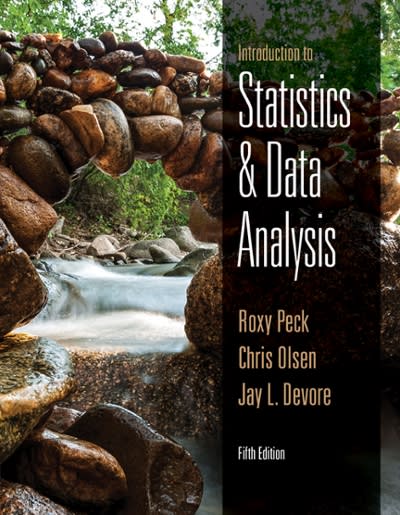Components 1 and 2 form a series subsystem, as do Components 3 and 4. The two subsystems
Question:
Components 1 and 2 form a series subsystem, as do Components 3 and 4. The two subsystems are connected in parallel. Suppose that P(1 works) 5 .9 P(2 works) 5 .9 P(3 works) 5 .9 P(4 works) 5 .9 and that the four components work independently of one another.
a. The 1–2 subsystem works only if both components work. What is the probability of this happening?
b. What is the probability that the 1–2 subsystem doesn’t work? that the 3–4 subsystem doesn’t work?
c. The system won’t work if the 1–2 subsystem doesn’t work and if the 3–4 subsystem also doesn’t work. What is the probability that the system won’t work? that it will work?
d. How would the probability of the system working change if a 5–6 subsystem were added in parallel with the other two subsystems?
e. How would the probability that the system works change if there were three components in series in each of the two subsystems?
6.52 Information from a poll of registered voters in Cedar Rapids, Iowa, to assess voter support for a new school tax was the basis for the following statements (Cedar Rapids Gazette, August 28, 1999):
The poll showed 51% of the respondents in the Cedar Rapids school district are in favor of the tax. The approval rating rises to 56% for those with children in public schools. It falls to 45% for those with no children in public schools. The older the respondent, the less favorable the view of the proposed tax: 36% of those over age 56 said they would vote for the tax compared with 72% of 18- to 25-year-olds.
Suppose that a registered voter from Cedar Rapids is selected at random, and define the following events:
F 5 event that the selected individual favors the school tax C 5 event that the selected individual has children in the public schools O 5 event that the selected individual is over 56 years old Y 5 event that the selected individual is 18–25 years old
a. Use the given information to estimate the values of the following probabilities:
i. PsF d ii. PsFuCd iii. PsFuC C d iv. PsFuOd v. PsFuY d
b. Are F and C independent? Justify your answer.
c. Are F and O independent? Justify your answer.
Step by Step Answer:

Introduction To Statistics And Data Analysis
ISBN: 9781305445963
5th Edition
Authors: Roxy Peck, Chris Olsen, Jay L Devore






